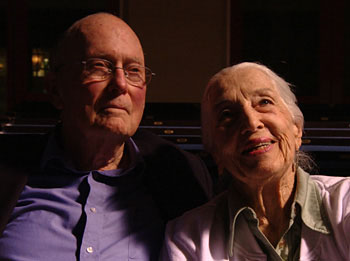
Charles Townes and his wife, Frances. [Image: Taran Singh/U.C. Berkeley News Center]
Charles Hard Townes, a giant of optical science and engineering and a key figure in the invention and early development of masers and lasers, died on 27 January 2015, almost exactly six months shy of his 100th birthday. His death was announced by the University of California, Berkeley, where Townes had been a faculty member for nearly half a century.
Born on 28 July 1915 in Greenville, S.C. (USA), Townes came of age in the rural South, growing up in a small farmhouse outside of the town. By his own account in his memoir, he was drawn at an early age to experimentation and hardware, and by age 16 had entered Furman University in Greenville, graduating several years later summa cum laude with degrees in modern languages and physics. He received his Ph.D. from the California Institute of Technology and, immediately before the outbreak of World War II, joined the staff at Bell Labs, where he worked designing radar bombing systems and investigating microwave physics and engineering.
After the war, in 1948, Townes accepted a faculty position at Columbia University, New York, where he continued his microwave work and, in particular, confronted the problem of how to create a high-intensity microwave beam to use in spectroscopy. Townes later recounted that the resolution to the problem, which ultimately led to the maser, came to him in the spring of 1951 during a period of reflection in an azalea garden in Washington, D.C., where he had come for a scientific conference.
He returned to Columbia and, with graduate student James Gordon and postdoctoral associate H.J. Ziegler, went on to develop the maser. Several years later, with colleague Arthur Schawlow, he developed the idea of an “optical maser” that would extend amplification into the realm of visible light, but the first actual laser demonstration was achieved by Theodore Maiman in 1960. (Townes was also one of the dramatis personae in a long-running patent dispute over early laser discoveries.) In 1964, he shared the Nobel Prize in Physics with two Soviet scientists, Aleksandr M. Prokhorov and Nicolai G. Basov, “for fundamental work in the field of quantum electronics, which has led to the construction of oscillators and amplifiers based on the maser-laser principle.”
Forty-nine years old when he received the Nobel Prize, Townes did not stand still in the second half of his career. After leaving Columbia in 1961 for a six-year stint as provost at the Massachusetts Institute of Technology, in 1967 he moved to the University of California, Berkeley, as a “professor-at-large”; there, he applied his work on masers, spectroscopy, and infrared interferometry to problems in astronomy and space science. Among his work there were microwave studies that helped pave the way to the now widely accepted hypothesis of a supermassive black hole at the center of the Milky Way galaxy. He was still teaching and working at Berkeley as late as 2014. Last year he also memorably participated in a symposium honoring his maser colleague and friend James Gordon at the CLEO conference in San Jose, Calif., USA.
A devout Christian, Townes also spent his post-Nobel Prize years exploring the nexus between science and religion, in particular as the author of a widely read 1966 article on the subject published in IBM's Think magazine and, later, in the journal Zygon. In 2005, he received the Templeton Prize for his work bridging science and faith. Townes himself believed that his insight on microwave amplification among the azaleas in Washington, D.C., was not much different from a religious revelation.
In addition to the Nobel Prize, Townes, an OSA Fellow, was the recipient of numerous other awards from the scientific community, including OSA’s Frederic Ives Medal and C.E.K. Mees Medal. He is survived by his wife of nearly 74 years, Frances Hildreth Townes, and their four daughters, six grandchildren, and two great-grandchildren.
